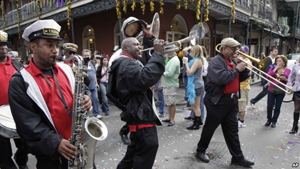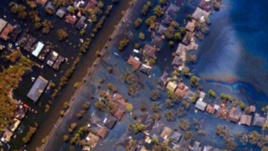Hello, and welcome to As It Is from VOA LearningEnglish!
I’m Christopher Cruise in Washington.
Today on the program we will hear music from one of the oldestneighborhoods in New Orleans, Louisiana..
 |
| The Treme Jazz Band in New Orleans, Louisiana |
“They be playin’ in the parks. They be playin’ in the Back Street CultureMuseum, and St. Augustine’s Church, and you can also catch them in CongoSquare playing New Orleans music.”
Music from a place with a style all its own, today on As It Is…
Brass Bands in New Orleans and on TV
Many people are still talking about the fourth and final season of the HBOtelevision program “Treme.” The show was set in a neighborhood unlike anyother. Treme is one of the oldest parts of New Orleans, and a place with astyle of music all its own.
New Orleans is the birthplace of jazz. And within thecity, many will tell you that jazz began in Treme, in aplace called “Congo Square.”
For almost 300 years, African-Americans have beencoming to Congo Square to play music and dance. And for over a century, the music they play and dance to has been the music of brass bands. Benny Jones, Sr. is the leader of the Treme Brass Band.
 |
“They be playin’ in the parks. They be playin’ in the Back Street CultureMuseum, and St. Augustine’s Church, and you can also catch them in CongoSquare playing New Orleans music.”
New Orleans is a city not just of jazz, but of parades -- everything from MardiGras parades to funeral parades. And when jazz musicians march in thestreet it is called “Second Line” music.
Benny Jones says the name “Second Line,” comes from the music’sbeginnings in the military.
“The band would play right behind the soldiers -- that’s where the brass bandgot the name ‘Second Line.’ They were playing marching music. So whenthey got to the streets, they changed the beat of the music. They put the NewOrleans beat in it, puttin’ the street beat on the bass drum and which a snaredrum would tie into it and therefore how come it come to be a Second Linebrass band.”
Much of the marching that Second Line brass bands do is to burial grounds.
 |
| Hurricane Katrina destruction |
“You can always -- at any given time -- you may see a band leaving a funeralparlor or church doing a New Orleans traditional jazz funeral. If you’re playingfor an older person, you’re looking for a strait-out, traditional Jazz funeral: ‘ACloser Walk with Thee,’ ‘In the Sweet By-And-By,’ ‘Precious Lord’ -- that isfuneral music. And when you’re playing for younger people, today they achefor the up-tempo music. So they hire a young band and they do a real up-tempo music for their funeral.”
In 2005, Hurricane Katrina destroyed much of NewOrleans. The Treme neighborhood was especiallyhard-hit. Benny Jones and most of his band moved to the western United States after the storm. Today,however, Treme is recovering. And Mr. Jones seesplenty to suggest that the area’s traditions will carry on.
“I played in the Young Men’s Olympic Parade. I’m theleader of a band -- they like traditional music. Rightbehind me they have another traditional band. In the back, they have another,modern music, now the younger band they play the up-tempo music, like therebirth music. So everybody’s playing a variety of music on the parade.”
Today, the music continues to change. Young people respect the brass bandtradition, while adding modern sounds like reggae and hip-hop. It is a kind ofmusic that keeps marching on.
And that’s our program for today. It was based on a story by reporter RichardPaul.
Next Monday on As It Is we will have another report about American music. We will tell about the growing popularity of mariachi music -- especially in thestates along the border with Mexico. And we will tell how some Americansused music to support and then oppose an amendment to the United StatesConstitution.
We would like to know what you want to hear about on a future show.
We read every message you send us.
Write to us at:
VOA Learning English
Washington, DC 20237 USA
Or send an e-mail to: LearningEnglish@VOANews.com
You can also go to our website -- learningenglish.voanews.com -- and click“Contact Us.” While you are there, you can read, listen to and download ourprograms.
You can follow us on Facebook, LinkedIn, iTunes, Twitter and on our YouTubeChannel, all at VOA Learning English.
I’m Christopher Cruise.
Thanks for listening!
Please join me next week at this same time for another report on Americanmusic, here on As It Is.







